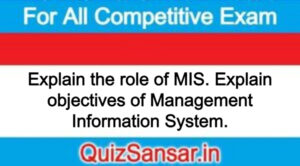
Explain the role of MIS. Explain objectives of Management Information System.
Explain the role of MIS. Explain objectives of Management Information System.
Ans.
The important roles of the MIS:
(i) The MIS satisfies the diverse needs through variety of systems such as query system, analysis system, modeling system and decision support system.
(ii) The MIS helps in strategic planning, management control, operational control and transaction processing. The MIS helps in the clerical personnel in the transaction processing and answers the queries on the data pertaining to the transaction, the status of a particular record and reference on a variety of documents.
(iii) The MIS helps the junior management personnel by providing the operational data for planning, scheduling and control and helps them further in decision-making at the operation level to correct an out of control situation.
(iv) The MIS helps the middle management in short term planning, target setting and controlling the business functions. It is supported by the use of the management tools of planning and control.
(v) The MIS helps the top level management in goal setting, strategic planning and evolving the business plans and their implementation.
(vi) The MIS plays the role of information generation, communication, problem identification and helps in the process of decision-making. The MIS, therefore, plays a vital role in the management, administration and operation of an organization.
The following are the objectives of a management information system :
1. MIS is very useful for efficient and effective planning and control functions of the management. Management is the art of getting things done through others. MIS will be instrumental in getting the things done by providing quick and timely information to the management.
2. Reports give an idea about the performance of men, materials, machinery, money and management. Reports throw light on the utilization of resources employed in the organization.
3. MIS is helpful in controlling costs by giving information about idle time, labor turnover, wastages and losses and surplus capacity.
4. By making comparison of actual performance with the standard and budgeted performance, variances are brought to the notice of the management by MIS which can be corrected by taking remedial steps.
5. MIS brings to the notice of the management strength (i.e., strong points) of the organization, to take advantage of the opportunities available.
6. MIS reports on production statistics regarding rejection, defective and spoilage and their effect on costs and quality of the products.






